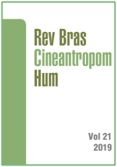Neuromuscular and motor patterns in breaststroke technique
DOI:
https://doi.org/10.1590/1980-0037.2019v21e56408Resumen
The aim of this study was to analyze the inter-temporal neuromuscular and motor patterns in breaststroke technique. Five national level male swimmers performed 200 m breaststroke at maximal effort. Electromyography data onbiceps brachii, deltoid anterior, pectoralis major and triceps brachiiwere analysed. The relative duration of active and non-active phase and the average rectified value for the neuromuscular patterns were recorded. The swim bouts were videotaped in sagittal plane with a pair of cameras and the Theme software 5.0 was used toanalyse the detected patterns in each swimmer. The neuromuscular pattern revealed that by the average rectified value the biceps brachiiand triceps brachiiwere increased at the end of the test for swimmers 1 and 5, while biceps brachii, deltoid anteriorand pectoralis majorwere increased for swimmers 2 and 4. Different motor patterns between cycles, and between swimmers were observed.We found similarities between the swimmers, adjusting their style to the technical model. The absence of a neuromuscular pattern for all swimmers could be related to different technical models used by each swimmer, as presented in the motor patterns. These findings suggested that each swimmers adapted their own motor and neuromuscular pattern in a unique and distinct way.
Citas
Troup J, Daniels J. Swimming economy: an introductory review. J Swimming Research 1986; 2:5-9.
Clarys J. A review of EMG in swimming: explanation of facts and/or feedback information. In: Hollander, P. Huijing, G. Groot (eds), Biomechanics and medicine in swimming 1983; pp.123-135. Champaign, Illinois, USA.
Ikuta J, Matsuda Y, Yamada Y, Kida N, Oda S, Moritani T. Relationship between decreased swimming velocity and muscle activity during 200-m front crawl. Eur J App Physiol 2012; 112: 3417-29.
Barbosa T, Marinho D, Costa M, Silva A. Biomechanics of Competitive Swimming Strokes. In Biomechanics in Applications, Rijeka: In Tech 2011; 367-388.
Caty V, Rouard A, Hintzy Y, Aujoannet Y, Molinari M, Knaflitz M. Time-frequency parameters of wrist muscles EMG after an exhaustive freestyle test. Port J Sp Scie 2006; 6:28-30.
Rouard A, Clarys J. Cocontraction in the elbow and shoulder muscles during rapid cyclic movements in an aquatic environment. J Electromyogr Kinesiol 1995; 5:77–183.
Stirn I, Jarm T, Kapus V, Strojnik V. Evaluation of muscle fatigue during 100-m front crawl. Eur J Appl Physiol 2011; 111:101-13.
Nuber GW, Jobe FW, Perry J, Moynes DR, Antonelli D. Fine wire electromyography analysis of muscles of the shoulder during swimming. Am J Sports Med 1986; 14:7-11.
Ruwe PA, Pink M, Jobe FW, Perry J, Scovazzo ML. The normal and the painful shoulders during the breaststroke. Electromyographic and cinematographic analysis of twelve muscles. Am J Sports Med 1994; 22: 789-796.
Conceição A, Gamboa H, Palma S, Araújo T, Nunes N, Marinho D, et al. Comparison between the standard average muscle activation with the use of snorkel and without snorkel in breaststroke technique. In: XITH International Symposium Biomechanics and Medicine in Swimming, Oslo. Abstract Book. 2010; pp. 46-47.
Louro H, Silva AJ, Anguera T, Marinho D, Oliveira C, Conceição A. et al. Stability of patterns of behavior in the butterfly technique of elite swimmers. J Sport SciMed 2010; 9:36-50.
Marinho D, Rouboa A, Alves F, Vilas-Boas JP, Machado L, Reis, V, et al. Hydrodynamics analysis of different thumb positions in swimming. J Sport Sci Med 2009; 8: 58-66.
Campaniço J, Santos J, Silva A. Breaststroke swimming patterns from video sequences analyzes. Produced by specific field formats. In: Biomechanics and Medicine in Swimming, Portuguese J Sport Sci 2006; 6: 76-77.
Magnusson MS. Discovering hidden time patterns in behavior: T-patterns and their detection. Behav Res Methods Instrum Comput 2000; 32: 93-110.
Anguera MT, Blanco-Villaseñor A, Losada JL. Observation design, a key issue in the process of observation methodology. Method Behaviour 2001; 3:135-160.
Herrmens HJ, Freriks B. European recommendations for surface electromyography, results of the SENIAM project (CDrom). Roessingh Research and Development, Enschede, 1999.
Basmajian V, De Luca C. Muscles Alive. Williams and Willkins, Baltimore, USA, 1985.
Colman V, Persyn U. Diagnosis of the movement and physical characteristics leading to advice in breaststroke. Continental corse in swimming for coaches. Gelsenkirshen: FINA-COI-DSV, 1991.
Anguera MT, Blanco A, Losada JL, Ardá T, Camerino O, Castellano J, et al. Match and player analysis in soccer: computer coding and analytic possibilities. Int J Computer Sci Sport 2003; 2: 118-121.
Silva A, Alves F. Determinant Factors to Variation in Butterfly Velocity. In: R. Sanders, Y. Hong (eds), proceedings of XVIII International Symposium on Bimechanics in sports. Applied program: application of biomechanical study in swimming 2000; pp. 73-74.
Conceição A, Silva AJ, Palma S, Silva H, Gamboa H, Louro H. Electromyography in Front Crawl Technique -Case Study. Open Sports Sci J 2010; 3: 67 – 69.
Olstad B, Cabri J, Zinner C, Nunes N, Kjendlie, L. SEMG Measurements on land and water prior to and after 60-90 minutes of submersion (Swimming) are highly reliable. Port J Sp Scie 2011; 11:763-765.
Sarmento H, Anguera T, Campaniço J, Leitão J. Development and validation of a national system to study the offensive process in football. Medicina (Kaunas) 2010; 46: 401-407.
Conceição A, Puel F, Louro H, Morgado S, Seifert L. Glide effect in breaststroke technique: neuromuscular assessment. Sci Int 2018; 30(2): 233-237.
Ikai M, Ishii K, Miyashita M. An electromyographic study of swimming. J Phys Educ 1964; 7: 47-54.
Louro H, Silva A, Campaniço J, Matos T, Conceição A. Stability of behavior patterns in the 200m breaststroke. Rev Bras Cineantropom Hum 2016; 18(4): 401-410.
Colman V, Persyn U, Daly D, Stijnen V. A comparison of the intra-cyclic velocityvariation in breaststroke swimmers with flat and undulating styles. J Sports Sci 1998:16(7): 653-65.
Descargas
Publicado
Número
Sección
Licencia

Direitos Autorais para artigos publicados nesta revista são do autor, com direitos de primeira publicação para a revista. Em virtude da aparecerem nesta revista de acesso público, os artigos são de uso gratuito, com atribuições próprias, em aplicações educacionais e não-comerciais, desde que seja dada a atribuição. Esta obra foi licenciada com uma Licença Creative Commons Atribuição 4.0 Internacional - CC BY


